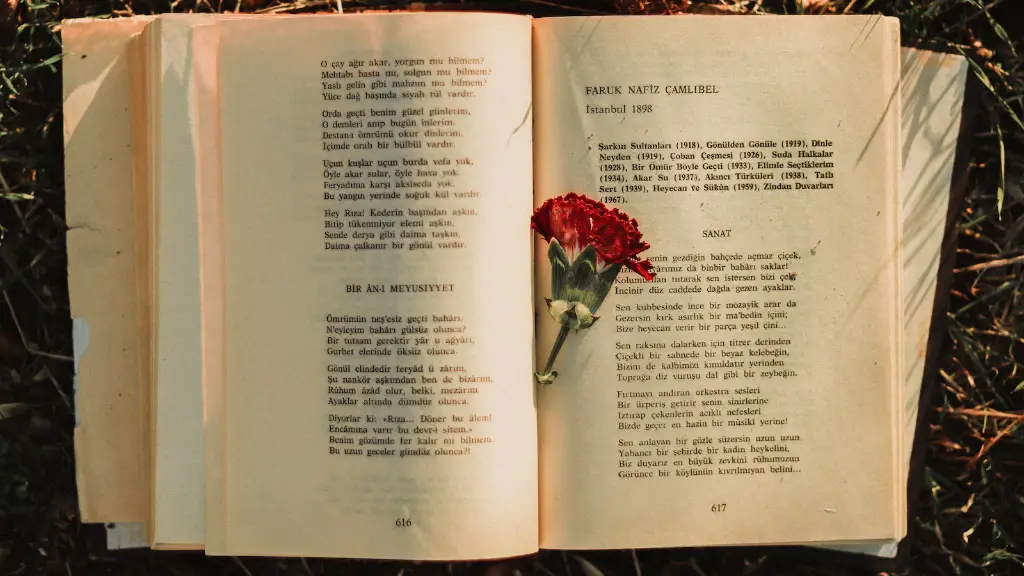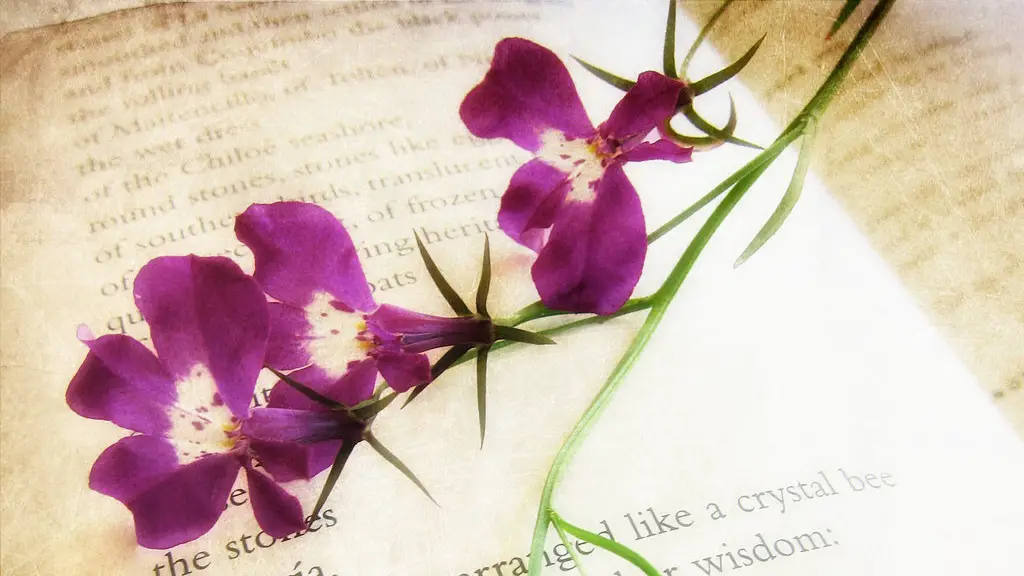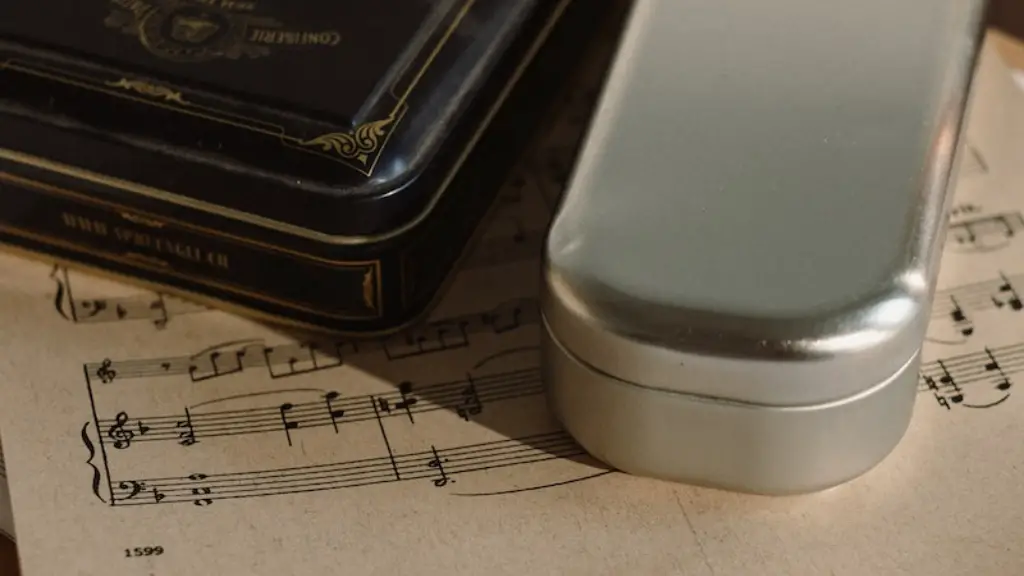Elements of Poetry
Poetry is an art form that has been around for thousands of years, and it is one that requires an excellent understanding of the literary techniques used to create beautiful and meaningful expression. In order to write a good poem, one must understand the fundamentals of what makes up a poem, including form, metre, rhyme and structure. All of these elements come together to form a poem that can be enjoyed by the reader.
Form is the overall arrangement of lines in a poem and can include stanzas, blank verse and free verse. Typically, a poem is divided into units with each unit marked off by punctuation. A stanza is a purposeful unit, usually with a regular metrical pattern and rhyme scheme. In some cases, a poem may also include elements of repetition and variation. For example, a poet may repeat a single line or phrase throughout the poem to lend a certain emphasis to the poem.
Metre is the use of rhythm in a poem in order to establish a certain sound and feeling. In English, metre is measured by the number of syllables in a line and the pattern and emphasis of the syllables. This means that the poet will select a pattern of stress and unstress syllables to fit the poem’s subject and meaning. This rhythm helps to create a certain atmosphere in the poem and draw the reader in.
Rhyme is the repetition of words, usually at the end of a line to create a pleasing sound. Rhyme schemes are organised in a certain way to create a pattern and flow. Rhyme can be used to create a certain mood or atmosphere in the poem and can be used to draw attention to important lines or words.
Structure is the arrangement of the poem’s lines and stanzas. This can vary from poem to poem and is used to enhance the meaning and impact of the poem. Some common structures used in poetry are the couplet, quatrain and the sonnet.
Creating Poems
When it comes to writing a poem, one of the most important things to know is the nature of the subject. Knowing the nature and feeling that is to be conveyed in the poem helps to inform the structure, rhyme, form and metre. For example, if a poem is about sadness, a fitting form would be a sad sonnet, rather than a jaunty limerick.
Once a subject has been chosen, poets can begin to think about the poem’s structure. This includes the deciding of the poem’s number of lines and the number of syllables in each line. This will depend on the poet’s preference and the effect that he or she wishes to achieve. Short lines can be used to give structure and shape to the poem, while longer lines can create an atmosphere of suspense and tension.
The poet can also consider whether or not to make use of rhyme and alliteration. Rhyme can be used to create a pleasing sound and feel, while alliteration can help to draw attention to certain words and ideas. The poet can also add words, images and metaphors to enhance the poem and make it more meaningful.
Finding Inspiration
Finding inspiration can often be the biggest challenge when writing poetry. Inspiration can come from many sources such as books, films, music and even daily observations. Writers can also get inspiration by reading and studying other poets’ works. This helps to give ideas and can help the writer to understand how others approach the art of poetry.
When looking for inspiration, writers can also consider nature and their own feelings and emotions. Taking a walk outside can help to clear one’s head and focus on the beauty of nature, while reflecting on one’s own thoughts and feelings can be a source of inspiration. These moments can help to create a spark of creativity and give the writer the impetus to begin writing.
The Writing Process
After finding inspiration, the writing process can begin. It is important for the writer to keep in mind the subject, form and structure of the poem. It is also a good idea to make use of drafts. This will help the writer to shape the poem and make amendments until it is perfected. It is often easier to work on a few lines at a time and then combine them together after the poem is finished.
Once the first draft is finished, the poem should be read aloud to ensure it follows the desired structure and sound. Making amendments at this stage can help to make the poem more powerful. After the poem is perfected, it is ready to be shared with an audience.
Editing and Publishing
When the poem is finished, the poet should consider getting feedback from editors or other writers. These people can give useful advice and suggest changes that may help to improve the poem further. Once the poem has been edited, the poet should consider submitting it to journals or newspapers for publication.
Writing and publishing a poem can be a challenging and rewarding experience. Those who wish to write poetry should aim to understand how to use the elements of poetry and how to create powerful and meaningful works of art.
Reciting Poetry
Reciting poetry is an excellent way to share it with others, and it is a great way to experience the poem in a more direct and intimate way. Reciting a poem aloud can help to bring it to life, as opposed to just reading it. This can give the poem more power and draw more attention to the emotions, images and ideas within it.
When reciting a poem, it is important to focus on the emotions and feelings associated with the words. This helps to make the poem more impactful, as it creates a connection between the poet and the audience. The poet should take their time when reciting the poem and consider their pacing, intonation and body language.
Using Poetry for Emotional Expression
Poetry can be an excellent tool for expressing emotions and feelings. Writing poetry can help to process emotions and thoughts, and it can also be used to explore issues and find personal meaning. By writing poetry, the writer can have an outlet to communicate their feelings and work through difficult topics.
Writing poetry can also be therapeutic, as it allows the writer to explore and express their emotions, while creating a beautiful piece of art. This can be a powerful tool for those who are struggling to come to terms with difficult situations, such as grief and trauma.
Conclusion
Writing poetry involves understanding the fundamentals of what makes up a poem, including form, metre, rhyme and structure. Finding inspiration for a poem can be challenging, but can come from many sources, including books, films, music and even daily observations. Writing a poem requires a knowledge of the subject, form and structure of the poem and making use of drafts to shape and amend the poem until it is finished. Editing and receiving feedback can help to make the poem more powerful, and reciting it aloud can bring it to life in a more direct and intimate way. Finally, poetry can be used to express emotions and can be therapeutic for those in difficult situations.




